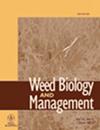西澳大利亚州骨杂草(juncea Chondrilla)管理的效益-成本分析
IF 1.5
4区 农林科学
Q3 AGRONOMY
引用次数: 0
摘要
本文估算了西澳大利亚主要杂草管理项目的投资回报率。生物经济模型用于估计有和没有该计划的情况下,随着时间的推移,大面积种植业的成本。结果表明,如果没有该计划,以澳元(A美元)表示的年度作物产量损失和种植成本增加可能在30年后达到1360万澳元 年。通过该计划,这些损失减少到500万澳元。如果每年的骨架杂草项目成本保持在340万澳元左右,该项目可能会在30年后为粮食生产商带来860万澳元的年度净收益 年。本文章由计算机程序翻译,如有差异,请以英文原文为准。
Benefit‐cost analysis of skeleton weed (
Chondrilla juncea
) management in Western Australia
This paper estimates the return on investment in the skeleton weed management program in Western Australia. A bioeconomic model is used to estimate costs to broadacre cropping industries over time with and without the program. Results suggest that without the program annual crop yield losses and increased growing costs, expressed in Australian dollars ($A), could reach A$13.6 million after 30 years. With the program, these losses reduce to A$5.0 million. If annual skeleton weed program costs remain approximately A$3.4 million, the program is likely to produce an annual net benefit to grain producers of A$8.6 million after 30 years.
求助全文
通过发布文献求助,成功后即可免费获取论文全文。
去求助
来源期刊

Weed Biology and Management
农林科学-农艺学
CiteScore
2.70
自引率
0.00%
发文量
13
审稿时长
>36 weeks
期刊介绍:
Weed Biology and Management is an international journal, published four times per year. The journal accepts contributions in the form of original research and review articles in all aspects of weed science. Contributions from weed scientists in the Asia–Pacific region are particularly welcomed.
The content of the contributions may relate to weed taxonomy, ecology and physiology, weed management and control methodologies, herbicide behaviors in plants, soils and environment, utilization of weeds and other aspects of weed science. All contributions must be of sufficient quality to extend our knowledge in weed science.
 求助内容:
求助内容: 应助结果提醒方式:
应助结果提醒方式:


